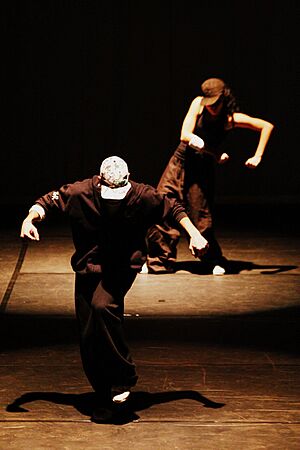Street dance facts for kids
Street dance is a type of dance that started outside of dance studios. People created these dances in everyday places like streets, parks, and schoolyards. It began in the 18th century and became very popular in cities, especially among African-American communities.
Street dance is all about being free and creative. There are no strict rules. Dancers often make up moves on the spot, which is called improvisation or freestyle. It's a way to express music with your body in a fun and energetic way.
Contents
Types of Street Dance
There are many different types, or genres, of street dance. They are often grouped into two main styles: Old School and New School. The year 1984 is often used as a dividing line because new technologies changed cities and youth cultures.
Old School Styles
Old School street dances were popular before 1984. They include styles like tap, locking, popping, and breakdancing.
Tap Dance
Tap dance was created by Irish and African-American people in the early 1800s. Dancers wear special shoes with metal plates on the heels and toes. These plates make rhythmic sounds when they hit the floor. Tap dance was one of the first dances to be called "street dance."
Locking
Locking started in 1970 with funk dancers in clubs. A dancer named Don Campbell is said to have invented the main "lock" move. This dance is known for being funny and lively. Basic moves include quick stops, wrist rolls, and hand claps.
Popping
Popping comes from the west coast of the United States. It involves quickly tightening and relaxing your muscles to create a jerky, robotic effect. Dancers mix this basic idea with other moves like waving (making your body look like a wave) and ticking (small, precise movements). It's thought to have developed from the robot dance.
Breakdancing
Breakdancing began in the early 1970s. It started when DJs (like DJ Kool Herc) played looped parts of songs called "breakbeats." Dancers created new moves to this music. Breakdancers are called b-boys (for boys) and b-girls (for girls).
Breakdancing has two main types of moves:
- Power moves are athletic and involve spinning or flipping, like the windmill or headspin.
- Style moves are about being creative and include freezes (holding a pose) and footwork (quick steps on the floor).
Newer forms like uprock and toprock are danced standing up, often before going down to the floor.
New School Styles
New School street dances became popular after 1984. These include hip hop, house, and techno.
Hip Hop Dance
Hip hop is one of the most famous street dance styles. It's part of a bigger culture that includes art, music, poetry, and fashion. Just like other street dances, hip hop dance has no strict rules. Freestyle Hip Hop is very popular, where dancers make up moves on the spot.
Today, hip hop dance often involves groups of dancers called crews. These crews compete in dance battles. This can be a positive way for young people to express themselves and compete in a healthy way. Hip hop dance gives many young people a fun and active hobby.
House Dance
House dance started in Chicago and became popular in New York clubs in the early 1980s. It was first influenced by dances like jacking and lofting. Later, moves from other styles, like hip hop, were added. House dance is very energetic and expressive, with a hopping feel to the moves. Some basic steps include the sidewalk, happy feet, and skating.
One popular form of house dance is waacking. Waacking involves quick arm movements and poses. It has mixed with other dance styles over time.
Techno Dance
Techno dance became popular in the early 1980s. It was influenced by electronic music. One early electronic dance was the electric boogaloo, which mixed breakdancing with electronic rhythms.
As electronic music grew, new street dances developed. In Europe, street dance culture includes house and techno dance. Different countries have created their own unique techno dance styles. For example, Australia has the Melbourne shuffle, and Europe has dances like hakken and jumpstyle. Modern techno dance is often about feeling the music rather than competing.
Images for kids
See also
 In Spanish: Baile urbano para niños
In Spanish: Baile urbano para niños



